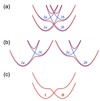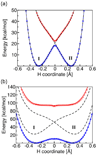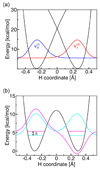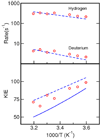Proton-coupled electron transfer in solution, proteins, and electrochemistry
- PMID: 18842015
- PMCID: PMC2720037
- DOI: 10.1021/jp805876e
Proton-coupled electron transfer in solution, proteins, and electrochemistry
Abstract
Recent advances in the theoretical treatment of proton-coupled electron transfer (PCET) reactions are reviewed. These reactions play an important role in a wide range of biological processes, as well as in fuel cells, solar cells, chemical sensors, and electrochemical devices. A unified theoretical framework has been developed to describe both sequential and concerted PCET, as well as hydrogen atom transfer (HAT). A quantitative diagnostic has been proposed to differentiate between HAT and PCET in terms of the degree of electronic nonadiabaticity, where HAT corresponds to electronically adiabatic proton transfer and PCET corresponds to electronically nonadiabatic proton transfer. In both cases, the overall reaction is typically vibronically nonadiabatic. A series of rate constant expressions have been derived in various limits by describing the PCET reactions in terms of nonadiabatic transitions between electron-proton vibronic states. These expressions account for the solvent response to both electron and proton transfer and the effects of the proton donor-acceptor vibrational motion. The solvent and protein environment can be represented by a dielectric continuum or described with explicit molecular dynamics. These theoretical treatments have been applied to numerous PCET reactions in solution and proteins. Expressions for heterogeneous rate constants and current densities for electrochemical PCET have also been derived and applied to model systems.
Figures














Similar articles
-
Theory of proton-coupled electron transfer in energy conversion processes.Acc Chem Res. 2009 Dec 21;42(12):1881-9. doi: 10.1021/ar9001284. Acc Chem Res. 2009. PMID: 19807148 Free PMC article.
-
Explaining Kinetic Isotope Effects in Proton-Coupled Electron Transfer Reactions.Acc Chem Res. 2025 Apr 15;58(8):1335-1344. doi: 10.1021/acs.accounts.5c00119. Epub 2025 Apr 4. Acc Chem Res. 2025. PMID: 40184268
-
Proton-coupled electron transfer versus hydrogen atom transfer: generation of charge-localized diabatic states.J Phys Chem A. 2011 Mar 24;115(11):2367-77. doi: 10.1021/jp111210c. Epub 2011 Feb 25. J Phys Chem A. 2011. PMID: 21351757
-
Comparison of hydride, hydrogen atom, and proton-coupled electron transfer reactions.Chemphyschem. 2002 Jan 18;3(1):33-42. doi: 10.1002/1439-7641(20020118)3:1<33::AID-CPHC33>3.0.CO;2-6. Chemphyschem. 2002. PMID: 12465474 Review.
-
Theoretical Modeling of Electrochemical Proton-Coupled Electron Transfer.Chem Rev. 2022 Jun 22;122(12):10599-10650. doi: 10.1021/acs.chemrev.1c00929. Epub 2022 Mar 1. Chem Rev. 2022. PMID: 35230812 Review.
Cited by
-
Modifications of protein environment of the [2Fe-2S] cluster of the bc1 complex: effects on the biophysical properties of the rieske iron-sulfur protein and on the kinetics of the complex.J Biol Chem. 2010 Mar 19;285(12):9233-48. doi: 10.1074/jbc.M109.043505. Epub 2009 Dec 20. J Biol Chem. 2010. PMID: 20023300 Free PMC article.
-
Strategies for Enhancing the Rate Constant of C-H Bond Cleavage by Concerted Proton-Coupled Electron Transfer.J Am Chem Soc. 2019 Sep 25;141(38):15183-15189. doi: 10.1021/jacs.9b06849. Epub 2019 Sep 12. J Am Chem Soc. 2019. PMID: 31464122 Free PMC article.
-
Proton-Electron Transfer to the Active Site Is Essential for the Reaction Mechanism of Soluble Δ9-Desaturase.J Am Chem Soc. 2020 Jun 10;142(23):10412-10423. doi: 10.1021/jacs.0c01786. Epub 2020 May 29. J Am Chem Soc. 2020. PMID: 32406236 Free PMC article.
-
Origins of Enzyme Catalysis: Experimental Findings for C-H Activation, New Models, and Their Relevance to Prevailing Theoretical Constructs.J Am Chem Soc. 2017 Dec 27;139(51):18409-18427. doi: 10.1021/jacs.7b08418. Epub 2017 Dec 15. J Am Chem Soc. 2017. PMID: 29244501 Free PMC article.
-
Systematic Quantification of Electron Transfer in a Bare Phospholipid Membrane Using Nitroxide-Labeled Stearic Acids: Distance Dependence, Kinetics, and Activation Parameters.Langmuir. 2020 Sep 8;36(35):10429-10437. doi: 10.1021/acs.langmuir.0c01585. Epub 2020 Aug 25. Langmuir. 2020. PMID: 32787070 Free PMC article.
References
-
- Roberts JA, Kirby JP, Nocera DG. Journal of the American Chemical Society. 1995;117:8051.
-
- Reece SY, Nocera DG. Journal of the American Chemical Society. 2005;127:9448. - PubMed
-
- Rosenthal J, Nocera DG. Accounts of Chemical Research. 2007;40:543. - PubMed
-
- Irebo T, Reece SY, Sjodin M, Nocera DG, Hammarstrom L. Journal of the American Chemical Society. 2007;129:15462. - PubMed
-
- Sjodin M, Styring S, Akermark B, Sun L, Hammarstrom L. Journal of the American Chemical Society. 2000;122:3932.
Publication types
MeSH terms
Substances
Grants and funding
LinkOut - more resources
Full Text Sources

